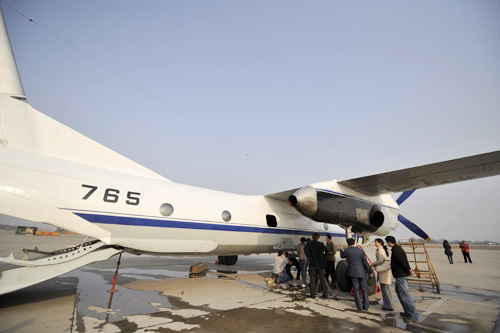|
 |
|
CLOUD SEEDING: Staff members of Hubei Provincial Meteorological Bureau install devices onto a plane to disperse silver iodide and induce precipitation (HAO TONGQIAN) |
A long-awaited rain on the morning of August 10 left drought-stricken residents in Linquan County, east China's Anhui Province, exalted. Farmers flocked to corn fields to check crops and spread fertilizer.
Since late July, Anhui had been parched by drought and temperatures above 35 degrees Celsius. Tens of thousands of people faced shortages of drinking water and large areas of crops were damaged.
It was much needed, for the cost of pumping ground water to irrigate the fields was high.
Yet farmers might not be aware that this 22-52 mm downpour was the result of a weather modification operation carried out by the Fuyang Meteorological Bureau, which had launched cloud seeding rockets to induce precipitation.
Weather modification is a frequent practice in China. The number of weather modification operations carried out in the country is the highest in the world, according to the China Meteorological Administration (CMA).
Zheng Guoguang, head of the CMA, said in May that artificial rain enhancement operations had covered more than half of the country's territory.
Data released by the CMA show that China has carried out nearly 559,000 weather modification operations since 2002, launching more than 900,000 rockets and 8.85 million shells. The effort created an estimated 489.7 billion tons of rainfall.
The country's weather modification system employs 47,700 people, and has an arsenal including more than 7,034 rocket launchers, more than 50 planes and nearly 6,902 guns.
On August 30, the Chinese Government published a plan, outlining that the country's aims to build a relatively complete weather modification system by 2020.
The document says that by 2020, China plans to increase precipitation by 60 billion tons annually via cloud seeding, as well as extend the coverage of artificial hail suppression to more than 540,000 square km from the current 470,000 square km, a near 15-percent increase.
"Weather has been modified to relieve drought, prevent forest fire, protect ecological environment, fill reservoirs, ensure good weather for major events, cool down cities and improve urban environment," said Wang Guanghe, Deputy Director of the Artificial Weather Intervention Center under the CMA.
Commonplace weather modification operations include rainfall adjustment by dispersing a catalyst to the clouds to delay or induce rain as well as measures to suppress hail, dissipate clouds, prevent frost and blunt lightning storms.
According to Yu Ziping, Deputy Chief Engineer of the China Enginery Research Institute, there are two cloud seeding processes: One is to use ice-forming substances such as silver iodide or dry ice to freeze super-cooled water droplets in a cold cloud, and the other is to use water-attracting substances such as salt to cause droplets to condense within a warm cloud.
"Catalysts can be dispersed into cloud by planes, guns, rockets and in some circumstances, natural air currents," Zheng said.
The potential for average artificial rainfall in China could reach up to 280 billion tons per year, which is seven times the storage capacity of the Three Gorges reservoir, the country's largest.
The CMA said that in the next five years, it will increase the efficiency of artificial rain enhancement by 3 to 5 percent, and expand the operation area of hail suppression by 5 percent.
"China generally is dry, so it explores all available measures to increase precipitation," said Mao Jietai, a professor at the Department of Atmospheric and Oceanic Sciences of Peking University's School of Physics.
Mao said that drought is a major meteorological disaster that threatens the country's food and environmental security, and the per-capita water availability in China is less than one fourth of the world average.
| 